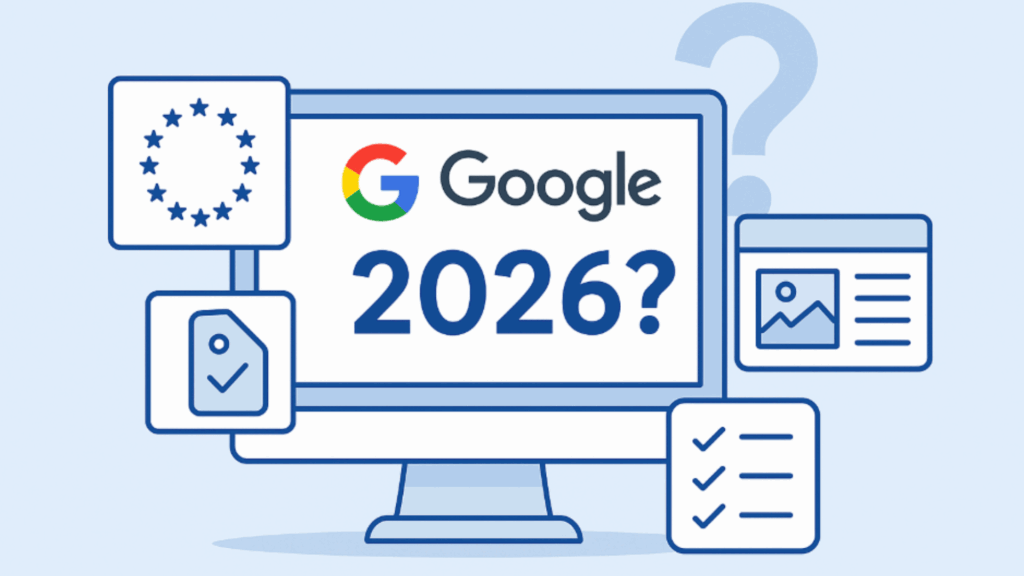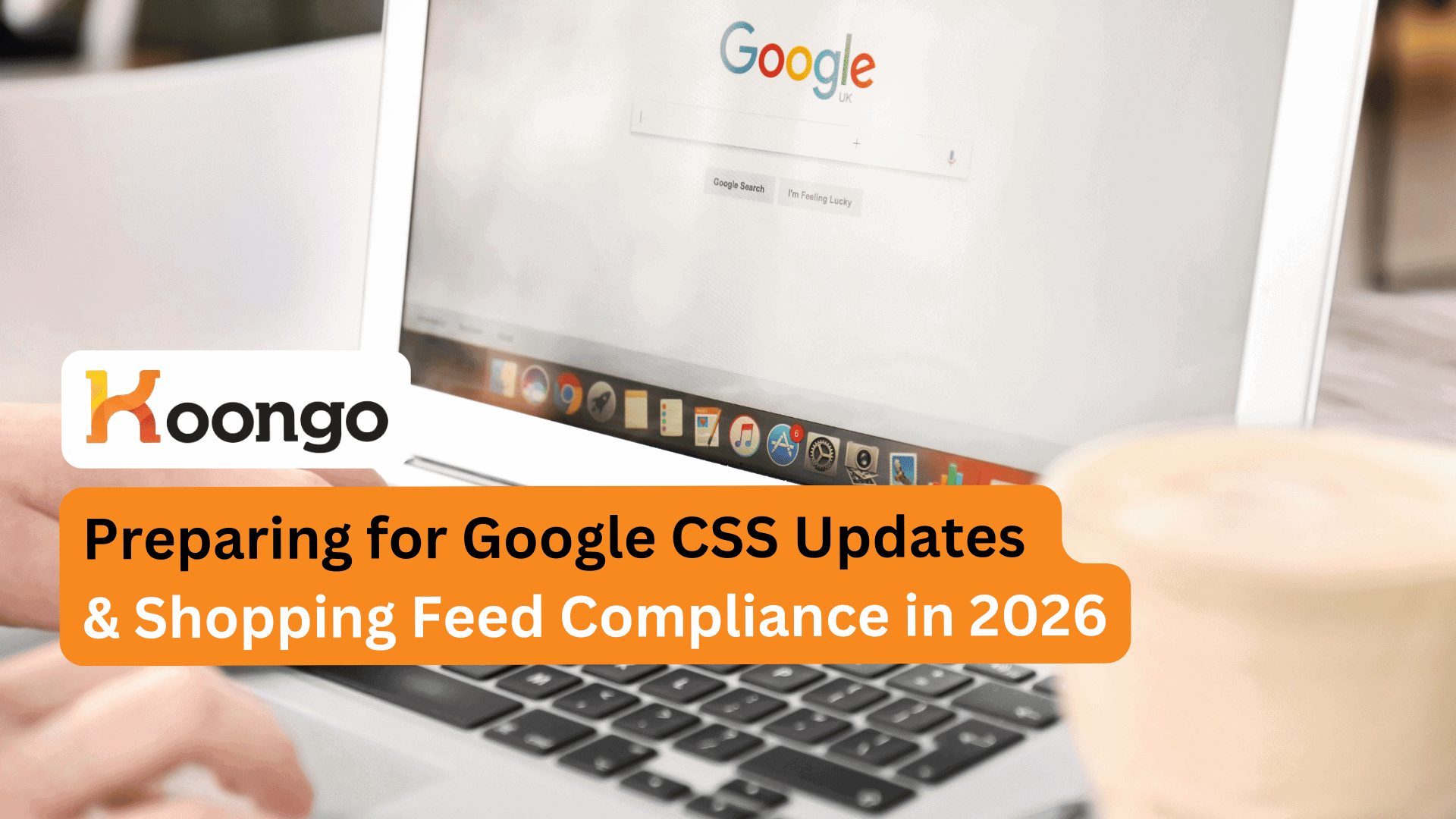As Google prepares to roll out significant updates to its Comparison Shopping Services (CSS) and Google Shopping feed requirements in 2026, eCommerce merchants face a new level of complexity. Stricter data standards, mandatory policy integrations, and enhanced compliance checks will soon redefine how product listings are structured and approved. Failing to adapt could mean disapproved listings, higher ad costs, or lost visibility across EU markets. In this guide, we’ll break down the key changes, the risks of inaction, and how Koongo helps you stay compliant, competitive, and fully optimized, well ahead of the deadline.
What is Google CSS?
Comparison Shopping Services (CSS) are platforms that allow online retailers to promote their products on Google Shopping through approved third-party providers. Originally introduced to comply with EU antitrust regulations, CSS enables merchants to display their ads in the Google Shopping tab via alternative providers, not just through Google Shopping itself. Retailers can partner with a CSS to benefit from lower cost-per-clicks (CPCs) and expanded ad placement opportunities.
When a merchant participates in the CSS program, their product ads are labeled with “By [CSS name]” instead of “By Google,” indicating a non-Google partner is handling the placement. This system has become standard practice for European sellers and agencies looking to improve ROAS across multiple marketplaces.

Google CSS Updates Coming in 2026
As of mid-2025, Google has signaled a series of major policy and structural updates to the Google CSS program that will take effect throughout 2026. These updates aim to improve product data transparency, unify regulatory compliance across EU markets, and boost user experience by ensuring accuracy and consistency in product listings.
Here are the most critical upcoming changes:
a. Stricter Data Attribute Requirements
Google will enforce more detailed and standardized product attributes. Fields like gender, age_group, material, and size_type will become mandatory for categories like fashion, accessories, health products, and furniture. More granular product_type structures will also be required to ensure proper ad targeting and user matching.
b. Verified Pricing & Tax Accuracy
To combat growing issues with pricing discrepancies between ad listings and landing pages, Google will require verified price matching and tax inclusion in feed submissions. This includes clear breakdowns of discounts, multi-pack pricing, and cross-border VAT structures.
c. Mandatory Shipping & Return Policy Integration
Merchants will be obligated to embed detailed shipping and return policy information directly in their feeds, not just on-site. This includes delivery time estimates, return windows, restocking fees, and region-specific options.
d. Image Quality & Content Standardization
Google will crack down on low-quality images, watermarks, promotional overlays, or inconsistent dimensions. Expect a push toward dynamic image validation and clearer guidelines on lifestyle imagery versus product-focused visuals.
e. Multi-country Feed Structuring with Product ID Standardization
Retailers advertising across multiple EU countries through CSS will need to adopt uniform Global Trade Item Numbers (GTINs) or custom IDs. Product variants must clearly differentiate by attributes like color, size, language, and currency. This is aimed at streamlining approvals and reducing duplicate listing errors across regions.
Why These Changes Matter
These upcoming changes are not just bureaucratic red tape—they directly impact your visibility, ad performance, and ultimately, your bottom line. Here’s why you need to care:
- Ad Disapproval Rates Will Rise: If your feed doesn’t meet the new attribute or structure requirements, your ads could be rejected outright.
- Higher CPCs Due to Lower Quality Scores: Missing or inconsistent information will reduce ad quality, forcing Google to charge more per click to offset user dissatisfaction.
- Reduced Market Reach: Non-compliant listings may not show in certain EU countries or device types, which can fragment your multichannel strategy.
- Loss of Promotional Eligibility: Disorganized or incomplete product feeds can disqualify your store from promotional campaigns like seasonal events or sales extensions.
- Wasted Ad Budget: Poor compliance means fewer impressions, irrelevant clicks, or missed opportunities during high-intent shopping phases.

The Risk of Non-Compliance
Compliance with Google Shopping and CSS feed requirements has always been essential, but with the 2026 update, the margin for error shrinks significantly. Many merchants underestimate the risks, assuming they can “fix later” or “learn as they go.” This mindset leads to costly mistakes and missed revenue.
Consequences of Non-Compliance
a. Product Disapprovals
If your product feed fails to meet one or more of Google’s formatting, content, or policy requirements, the products will be disapproved and removed from Google Shopping entirely. Without visibility, you can’t drive traffic, and without traffic, you can’t convert.
b. Increased Cost-per-Click
Google uses a quality score mechanism that takes into account the accuracy and completeness of your product feed. Poor-quality listings get penalized with higher CPCs, meaning you’ll pay more for fewer clicks. With budget pressures rising, this can severely limit your ROAS.
c. Reduced Impressions and Lost Ad Placement
Even if your products aren’t disapproved outright, lack of optimized attributes (like missing size or gender in fashion) will hurt relevance, limiting where and when your ads appear. This reduces your visibility across devices, locations, and audience segments.
d. Account Suspension Risks
Chronic or intentional non-compliance, especially with pricing mismatches, can trigger warnings or even Merchant Center account suspensions. These are difficult and time-consuming to reverse, and can grind your entire campaign to a halt.
Common Mistakes That Trigger Non-Compliance
- Price Mismatch Between Feed and Product Page
If your feed says €19.99 but your landing page says €24.99 due to dynamic pricing, discount issues, or caching problems, expect product disapprovals. - Missing Shipping Costs
Leaving out shipping rates or timelines, especially in cross-border listings, can make your ads ineligible in certain markets. - Outdated Product Availability
Failing to update availability fields (e.g., in_stock, out_of_stock) can lead to poor user experience and listing removals. - Unstructured or Misleading Titles
Overloaded product titles with promotional language or keyword stuffing are now flagged more aggressively by Google’s AI review systems. - Low-Quality or Watermarked Images
Images with watermarks, logos, or poor resolution can get flagged, reducing ad quality and disqualifying the item for rich image formats.

New Requirements to Expect
To prepare for the 2026 update, let’s take a closer look at the specific feed requirements Google will be enforcing—and how merchants should adapt.
1. More Granular Attribute Requirements
Google is pushing for a deeper level of categorization and context. These fields are no longer optional:
- Size, Size Type, Size System – Required for apparel and footwear; must be standardized per region.
- Gender & Age Group – Mandatory for fashion, toys, personal care products.
- Material & Pattern – Required for many product types (e.g., bedding, clothing, accessories).
- Product Type – Use detailed, breadcrumb-style structure (e.g., Apparel > Women > Dresses > Maxi Dresses) instead of vague labels.
Koongo makes this easier by allowing you to create rule-based mapping logic and bulk assign attributes based on product tags or categories.
2. Shipping & Return Policies Embedded in Feeds
Google will require merchants to include region-specific shipping and return data within the feed itself, not just linked from your website. Key fields include:
- Shipping Cost and Region – Must define cost per country or postal code range.
- Delivery Time Estimate – Required for “Buy on Google” eligibility and for better ad placement.
- Return Period & Restocking Fee – Clear return windows (e.g., 30 days), any return charges, or restocking fees must be declared.
This change aims to ensure consistency in customer expectations across product listings.
3. Enhanced Images & Visual Quality
Merchants must provide:
- Clean Product Images – No logos, watermarks, borders, or promotional overlays.
- Consistent Dimensions & Backgrounds – Especially for variant listings like color swatches.
- Lifestyle Shots as Secondary Images – Preferred in verticals like home decor and fashion.
Use Koongo’s feed enrichment tools to auto-filter and validate image URLs before submission.
4. Structured Pricing & Promotion Metadata
New structured pricing fields will be introduced to support multi-level offers:
sale_price_effective_dateunit_pricing_measureandunit_pricing_base_measure- Promotional metadata for flash sales, bundles, and time-sensitive discounts
5. Multi-Country ID Standardization
For EU-wide CSS usage, product listings must include consistent and structured product identifiers across countries. This includes:
- GTIN or Brand + MPN Combo – Required for most categories.
- Language- & Currency-Specific Descriptions – Same product ID, localized for region.
- Country-specific availability, pricing, and shipping logic – Managed via multi-targeted feeds in Koongo.

How Koongo Helps You Stay Ahead
In the fast-evolving landscape of Google Shopping and CSS (Comparison Shopping Services) compliance, having a powerful and adaptive feed management solution isn’t optional—it’s essential. Koongo is designed to help merchants navigate these changes with ease, speed, and accuracy. Here’s how Koongo keeps you compliant and competitive in 2026 and beyond:
Automatic Feed Rule Updates Aligned with Google Changes
Google’s feed specification is dynamic—new rules, fields, and policies are added frequently, often with limited notice. Koongo monitors Google Merchant Center updates in real time and reflects those changes within its platform.
- Automatic syncing with Google feed requirements ensures your feed structure always matches the latest specifications.
- Dynamic field validation highlights missing or incorrect data as soon as new fields become mandatory.
- Country-specific rule sets allow for market-specific configurations, helping you stay compliant in all targeted EU countries.
Koongo takes the manual workload off your shoulders by staying ahead of every update.
Frequent Feed Validation and Issue Alerts
One of the biggest pain points in feed management is realizing too late that your products were disapproved due to avoidable issues. Koongo solves this with:
- Frequent validation that checks your product feed against Google’s policies and formatting rules.
- Automated error and warning alerts for missing attributes, disallowed image types, price mismatches, and more.
- Diagnostic tools that categorize issues and offer actionable solutions to resolve them quickly.
This system significantly reduces ad downtime and protects your revenue from technical setbacks.
Flexible Feed Templates for Different CSS Platforms
Koongo supports a broad range of CSS platforms active across Europe. Whether you work with Google Shopping CSS, Producthero, or custom third-party providers, Koongo ensures your feeds are aligned with each platform’s requirements.
- Pre-built templates allow for rapid deployment across multiple channels.
- Custom feed builder enables you to configure and maintain niche or less common CSS integrations.
- Version control allows you to run promotional or seasonal feed versions without disrupting your main feed.
This flexibility makes Koongo ideal for agencies and merchants operating in complex ad ecosystems.
Multi-Store and Multi-Country Support for Localized Compliance
Selling across different countries introduces complexity in pricing, tax, availability, and language. Koongo simplifies it all.
- Multi-currency and VAT handling ensures accurate pricing for each region.
- Attribute mapping by language helps you localize product data for each market.
- Individual store configurations let you manage feeds for multiple Shopify, Magento, WooCommerce, or custom eCommerce platforms from a single dashboard.
This level of control allows you to meet country-specific regulations without duplicating your workload.

Action Plan: What You Should Do Now
With the 2026 changes approaching, now is the time to act. Here’s a practical, step-by-step plan to get ahead using Koongo.
Step 1: Audit Your Current Feed
Understand where you stand by auditing your product data.
- Use Koongo’s built-in feed audit tool to evaluate completeness, accuracy, and formatting.
- Download our Google Shopping Readiness Checklist to spot common weaknesses.
- Focus your efforts on high-risk product categories like fashion, health, and home goods.
This baseline audit will reveal where updates are needed before compliance becomes mandatory.
Step 2: Set Up Koongo’s Feed Validation Rules
Configure rule-based automations that streamline your product data updates.
- Auto-populate missing fields such as gender, material, or pattern using product tags.
- Apply default shipping and return settings where individual data is missing.
- Use Koongo’s issue resolution tools to fix problems across your entire catalog in minutes.
Setting rules once can save hundreds of hours and eliminate manual errors.
Step 3: Optimize Attribute Mapping for Future Requirements
Prepare your product feed structure for the attributes Google will enforce in 2026.
- Replace generic category names with breadcrumb-style product types.
- Separate composite data into structured fields (for example, color, material, size).
- Take advantage of Koongo’s AI-suggested mappings for enhanced search accuracy and ad relevance.
This not only ensures compliance but also improves campaign targeting.
Step 4: Schedule Recurring Compliance Checks
Maintain compliance over time by setting up continuous monitoring.
- Schedule automated feed refresh intervals based on inventory and catalog changes.
- Set alert systems for new feed warnings or validation issues.
- Receive weekly or monthly feed health reports for ongoing optimization.
This makes compliance an ongoing strategy rather than a last-minute scramble.

Final Tips: Staying Updated Beyond 2026
Regulations and expectations will keep evolving. Merchants must remain agile and informed to maintain performance.
Set Alerts for Google Merchant Center Updates
Subscribe to Google’s Merchant Center newsletter and policy updates to get early insights on changes. Koongo also provides a dashboard with policy change summaries and field updates.
Subscribe to Koongo’s Feed Compliance Tracker
Koongo publishes a monthly digest covering:
- New feed field requirements
- Country-specific compliance updates
- Emerging best practices for feed optimization
- Practical insights on how these changes affect CTR, ROAS, and disapproval rates
This resource helps you make informed decisions as the market evolves.
Use Koongo to Manage Testing Feeds and Variations
A/B testing your feed setup ensures new strategies work before full rollout.
- Create staging feeds for test campaigns within Google Merchant Center.
- Experiment with product titles, images, and attribute configurations to improve ad visibility.
- Preview country-specific feed outputs to avoid localization issues.
This allows you to move fast while minimizing risks.
Koongo is more than just a feed tool—it’s your partner in staying Google-compliant and sales-optimized.
Start preparing for the 2026 Google Shopping updates today:
- Try Koongo’s Google Shopping feed integration for free and explore all platform features.
- Book a consultation with one of our eCommerce feed experts to assess your current setup and plan your 2026 strategy.
Get ready to sell more, spend smarter, and stay compliant with Koongo.
Continue reading →
 EN
EN 
